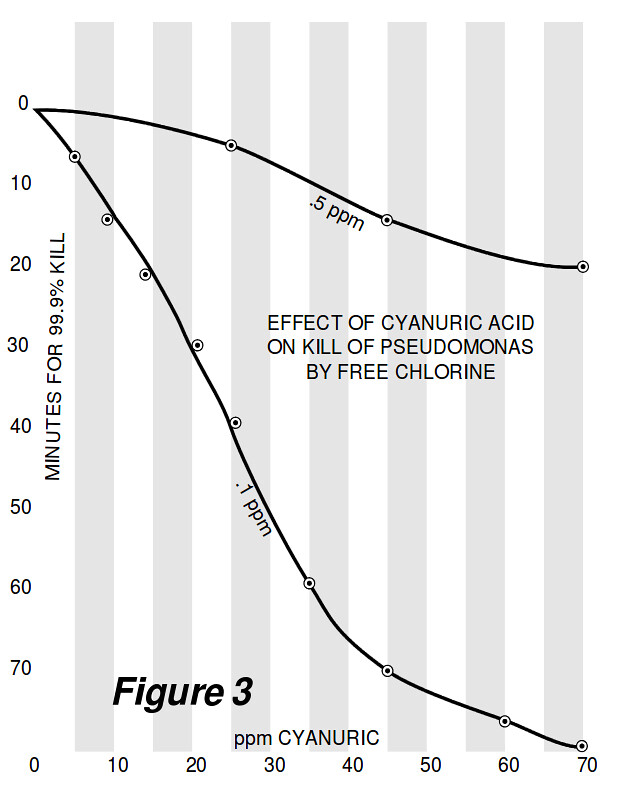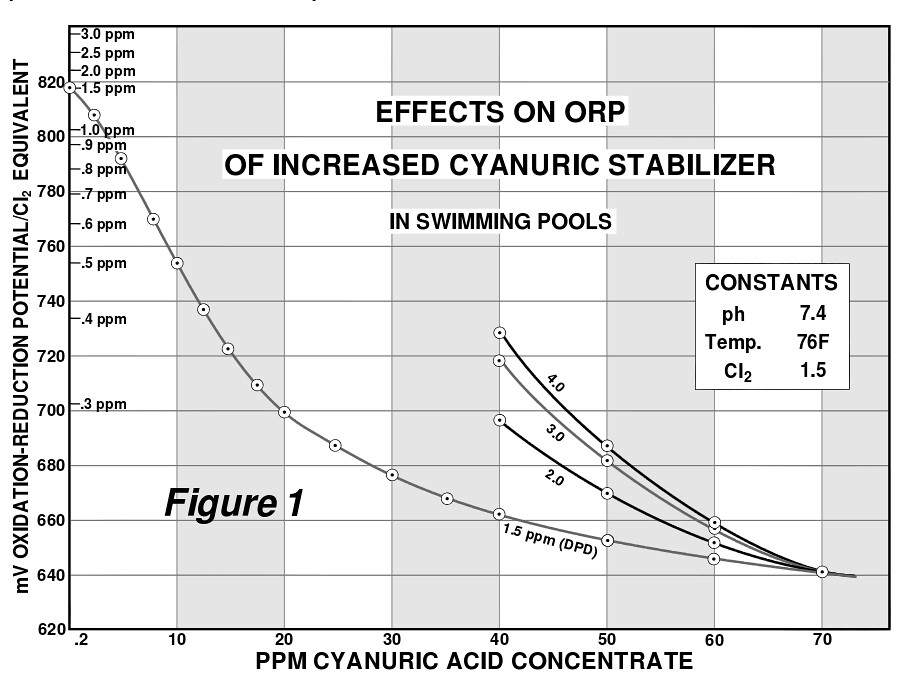While researching my local health department rules on FC/CYA ratios, I happened to run into this Richard Falk (aka chem_geek) paper on the net, which I point out so that others may read it:
- The Chlorine / Cyanuric Acid Relationship and Implications for Nitrogen Trichloride, by, Richard A. Falk
Also, I noticed this paper by Robert W. Lowry which proposes a FC-to-CYA ratio of 7.5%:
- Cyanuric Acid: It Controls Your Pool
And, I found this Pool Operators of America paper on FC-to-CYA ratio chemistry:
- Cyanurics ~ Benefactor or bomb? by Kent Williams, Executive Director of the Professional Pool Operators of America
Plus, I found this repeat TFP chart on the FC/CYA ratio recommendations:
Yet, as far as I can tell from my searches today, most public heath departments, while aware of the ratio implications, still persist in prescribing static minimum FC & maximum CYA levels.
For example, this quote shows that the Oregon public health department knows the relationship:
http://public.health.oregon.gov/Hea...PoolsLodging/Documents/pooltrainingbook09.pdf
Shields JM, Arrowood MJ, Hill VR, Beach MJ. The effect of cyanuric acid on the chlorine inactivation of Cryptosporidium parvum. J Water Health2008; 7(1): 109–114.
I'm searching for a public health department fact sheet that understands that the FC/CYA ratio (and not static levels) is what is important, but, I can't find any yet.
For example, this Lincoln Nebraska public health department "fact sheet" on CYA still persists in listing static minimum FC and maximum CYA levels:
- Fact Sheet on Cyanuric Acid and Stabilized Chlorine Products
Same with this Oregon Public Health Division "Pool Operator Training Manual".
So, if anyone here knows of any public health department which prescribes the RATIO of FC to CYA, that would be a useful reference.
- The Chlorine / Cyanuric Acid Relationship and Implications for Nitrogen Trichloride, by, Richard A. Falk
Also, I noticed this paper by Robert W. Lowry which proposes a FC-to-CYA ratio of 7.5%:
- Cyanuric Acid: It Controls Your Pool
And, I found this Pool Operators of America paper on FC-to-CYA ratio chemistry:
- Cyanurics ~ Benefactor or bomb? by Kent Williams, Executive Director of the Professional Pool Operators of America
Plus, I found this repeat TFP chart on the FC/CYA ratio recommendations:
Yet, as far as I can tell from my searches today, most public heath departments, while aware of the ratio implications, still persist in prescribing static minimum FC & maximum CYA levels.
For example, this quote shows that the Oregon public health department knows the relationship:
http://public.health.oregon.gov/Hea...PoolsLodging/Documents/pooltrainingbook09.pdf
Where the †† indicates this reference source:"Crypto CT inactivation values are based on killing 99.9% of Crypto. This level of Crypto inactivation *cannot be reached* in the presence of 50 ppm chlorine stabilizer, even after 24 hours at 40 ppm free chlorine, pH 6.5, and a temperature of 77°F (25°C). †† Extrapolation of these data suggest it would take approximately 30 hours to kill 99.9% of Crypto in the presence of 50 ppm or less cyanuric acid, 40 ppm free chlorine, pH 6.5, and a temperature of 77°F (25°C) or higher.
Shields JM, Arrowood MJ, Hill VR, Beach MJ. The effect of cyanuric acid on the chlorine inactivation of Cryptosporidium parvum. J Water Health2008; 7(1): 109–114.
I'm searching for a public health department fact sheet that understands that the FC/CYA ratio (and not static levels) is what is important, but, I can't find any yet.
For example, this Lincoln Nebraska public health department "fact sheet" on CYA still persists in listing static minimum FC and maximum CYA levels:
- Fact Sheet on Cyanuric Acid and Stabilized Chlorine Products
Same with this Oregon Public Health Division "Pool Operator Training Manual".
So, if anyone here knows of any public health department which prescribes the RATIO of FC to CYA, that would be a useful reference.




